
Groove milling, cut-off milling or gear milling: these are just three milling processes that the circular interpolation milling system from Paul Horn GmbH carries out productively. As a true all-rounder, the extensive tool portfolio of this system tackles several other milling processes. It can be used from an inside diameter of 8 mm (0.315") for precise boring, for slot milling of narrow grooves down to a width of 0.25 mm (0.009"), or for milling splines: The system has proven to be a problem solver in numerous standard variants as well as in special designs for individual requirements.
In order to further increase the chip removal volume during milling, Horn is expanding the circular milling system to include inserts with nine cutting edges. The smaller diameters of the system were previously available with a maximum of six cutting edges. Three more teeth offer further advantages. On one hand, the production time is shortened due to the higher cutting feed rates that are possible, while on the other hand, tool life is increased. In addition, the inserts run more quietly and with less vibration than inserts with fewer teeth. These advantages, in addition to the high milling performance of the tool system, contribute to higher overall efficiency and a reduction in tool costs.
The new nine-edged milling systems M911, M913 and M928 are stocked in cutting widths from 1.5 mm (0.059") to 3 mm (0.118") as standard. The maximum milling depth is 3.5 mm (0.138") (M911), 4.5 mm (0.177") (M913) and 6.5 mm (0.256") (M928). The inserts are available with different coatings to suit the material to be machined. Due to its mass, the solid carbide tool shank ensures vibration damping during milling. All variants of the tool shanks are equipped with an internal coolant supply.
Contact Details
Related Glossary Terms
- boring
boring
Enlarging a hole that already has been drilled or cored. Generally, it is an operation of truing the previously drilled hole with a single-point, lathe-type tool. Boring is essentially internal turning, in that usually a single-point cutting tool forms the internal shape. Some tools are available with two cutting edges to balance cutting forces.
- coolant
coolant
Fluid that reduces temperature buildup at the tool/workpiece interface during machining. Normally takes the form of a liquid such as soluble or chemical mixtures (semisynthetic, synthetic) but can be pressurized air or other gas. Because of water’s ability to absorb great quantities of heat, it is widely used as a coolant and vehicle for various cutting compounds, with the water-to-compound ratio varying with the machining task. See cutting fluid; semisynthetic cutting fluid; soluble-oil cutting fluid; synthetic cutting fluid.
- feed
feed
Rate of change of position of the tool as a whole, relative to the workpiece while cutting.
- gang cutting ( milling)
gang cutting ( milling)
Machining with several cutters mounted on a single arbor, generally for simultaneous cutting.
- interpolation
interpolation
Process of generating a sufficient number of positioning commands for the servomotors driving the machine tool so the path of the tool closely approximates the ideal path. See CNC, computer numerical control; NC, numerical control.
- milling
milling
Machining operation in which metal or other material is removed by applying power to a rotating cutter. In vertical milling, the cutting tool is mounted vertically on the spindle. In horizontal milling, the cutting tool is mounted horizontally, either directly on the spindle or on an arbor. Horizontal milling is further broken down into conventional milling, where the cutter rotates opposite the direction of feed, or “up” into the workpiece; and climb milling, where the cutter rotates in the direction of feed, or “down” into the workpiece. Milling operations include plane or surface milling, endmilling, facemilling, angle milling, form milling and profiling.
- shank
shank
Main body of a tool; the portion of a drill or similar end-held tool that fits into a collet, chuck or similar mounting device.

